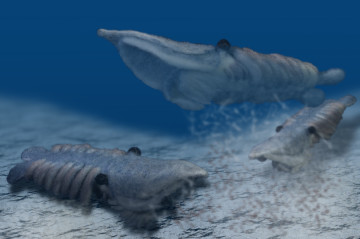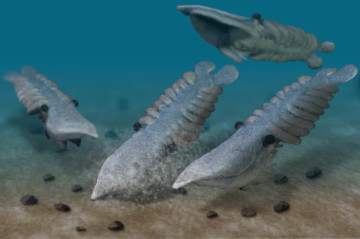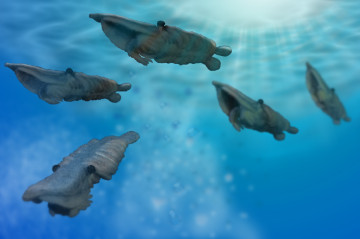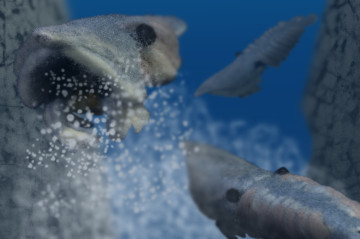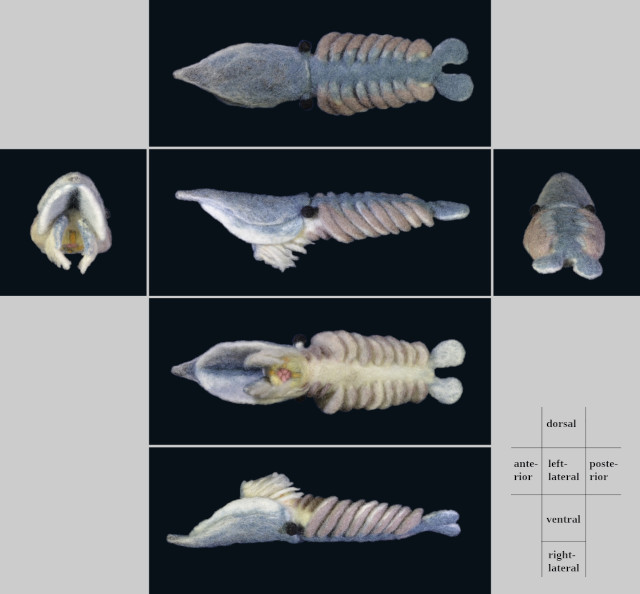Hurdia victoria
Hurdia victoria is a species of the order Radiodonta, lived in the Middle Cambrian 1), 2), 4). The body divides into two parts of nearly equal length, and is approximately 20 cm in length 1), 2), maximum size would be about 50 cm 4).
Generic name "Hurdia" is derived from Mount Hurd in Yoho National Park, British Columbia, Canada, and specific name "victoria" also from Mt. Victoria on the border of Yoho and Banff National Parks 4).
The anterior half is covered with a triangular dorsal H-element and a pair of lateral P-elements 1), 2). These frontal carapaces have posterior notches, and oval eyes with short annulated stalks protrude from there 1), 2).
The ventral side has a circular mouth consisted of outer and inner rows of teeth 1), 2). The outer teeth are radial arrangement of 32 small plates (of which four are large) forming a domed structure in lateral view 1), 2). The inner rows of teeth are seen within the square central opening, and would be a specific feature to Hurdia 1), 2).
A pair of appendages with long ventral spines flanks the mouth 1), 2). A range of motion is not so wide, therefor the appendages would not be good at catching agile prey 3).
The posterior half of the body is cylindrical shape 2) and has 7 - 9 pairs of lateral flaps extending at an oblique angle from the dorsal midline to the ventral midline 1), 2). The lanceolite structures are attached to the dorsal surface of each flaps, and are interpreted as gill-like respiratory organs 1), 2). The body ends with two rounded lobes 1, 2).
Presumably, Hurdia swan slowly near the seafloor, and swallowed their prey whole with suction created by turning the outer teeth inside out 2,3).
Furthermore, the frontal carapaces were used to dig and stir up sediment on the seafloor, then to funnel small animals leaping out from there towards the 'net' formed by the appendages 2), 4).
There are some interpretations that differ from conventional restorations: a) the head part extends nearly to the front end of the carapace, and the appendages and mouth part are located at the anterior end of head, far from the eyes, as in Cambroraster 5), b) Hurdia has two sets of flaps, both dorsal and ventral 6).
created in March 2017.
re-created in March - June 2023.
re-created in March - June 2023.
References:
- Daley AC, Budd GE, Caron JB, Edgecombe ED, Collins D (2009) The Burgess Shale Anomalocaridid Hurdia and Its Significance for Early Euarthropod Evolution [Abstract] Science 323 : 1597-1600. (DOI: 10.1126/science.116951) (The full-text was referred to ResearchGate.)
- Daley AC, Budd GE, Caron JB (2013) Morphology and systematics of the anomalocaridid arthropod Hurdia from the Middle Cambrian of British Columbia and Utah. [abstract] J. Sys. Palaeontol. 11(7):1477-2019. (DIO:10.1080/14772019.2012.732723".) (The full-text was referred to ResearchGate.)
- De Vivo G, Lautenschlager S, Vinther J. (2021) Three-dimensional modelling, disparity and ecology of the first Cambrian apex predators. Proc. R. Soc. B 288: 20211176. (DOI: 10.1098/rspb.2021.1176.)
- Hurdia victoria - The Burgess Shale (Royal Ontario Museum).
- Moysiuk J, Caron JB (2019) A new hurdiid radiodont from the Burgess Shale evinces the exploitation of Cambrian infaunal food sources. Proc. R. Soc. B 286:20191079. (DOI:10.1098/rspb.2019.1079)
- Van Roy P, Daley AC, Briggs DEG (2015) Anomalocaridid trunk limb homology revealed by a giant filter-feeder with paired flaps. [abstract, Supplementary Information] Nature 522:77–80. (DOI: 10.1038/nature14256.) (The full-text was referred to ResearchGate.)

